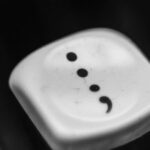
Backslash vs. Forward Slash: What’s the Difference?
If you look down at your keyboard, you’ll notice that there are two types of slashes: the backslash (\) and the forward slash (/). But do you know the difference between them and when to use each one? If not, don’t worry! In this blog post, we’ll explain:
- What a backslash is and when to use one
- What a forward slash is and when to use one
What Is a Backslash?
The backslash is mainly used in computing and mathematics.
The symbol has been given many different names in the past, and it can be hard to determine exactly when it first became popular. There’s a photo dating back to the mid-1930s that shows a Kleinschmidt keyboard perforator with a backslash. At that time, it was simply called the diagonal key.
The backslash isn’t technically a punctuation mark, so you wouldn’t normally come across it in most forms of writing. Rather, it’s a typographic mark that’s common in technical contexts. For example:
- If you’re on a Windows computer, you might notice that backslashes are used to denote file paths (such as C:\Users\Name\Documents).
- In many programming languages, the backslash serves as an escape character. In JavaScript, for instance, \’ represents a single quote and \” represents a double quote.
What Is a Forward Slash?
While a backslash has a very specific usage, the forward slash can be used for a number of different things.
1. To Separate Lines in Poetry
If more than one short line of writing is being written as one longer line, you can use the forward slash to show where the lines should be separated.
I saw two seagulls / And a red bird in a tree / Waiting there for spring.
Some style guides may prefer using line breaks or alternative symbols, though, so always check if you have specific instructions.
2. To Replace the Word or
In less formal writing, the forward slash can be used instead of the word or, but this should be done sparingly.
The diving instructor noticed that someone had left his/her towel on the beach.
3. To Show Relationships, Conflicts, and Alternatives
A forward slash can be used to show that two or more things have a close relationship, are in conflict, or represent alternatives.
They had a love/hate relationship.
The store accepts cash and/or credit cards.
The room is reserved for graduate students/faculty members/visiting lecturers.
4. To Form Abbreviations
In less formal writing, abbreviations can be created by combining letters with forward slashes.
w/o = without
a/c = air conditioning
n/a = not applicable
5. To Format Dates and Fractions
When using digits, slashes help separate the numbers for formatting dates and fractions.
He used ½ a cup of water.
She was born on 01/24/2020.
Note that date formats can vary between locations – for instance, international date format (ISO 8601) uses dashes in place of slashes. So be sure to check any style guidelines you’ve been asked to follow.
6. To Format URLs for Websites
One of the most common places you’ll see a forward slash is when typing out a website’s URL.
I read an informative article at https://knowadays.com/blog/.
In http:// or https://, there are two slashes, and you’ll typically see a single slash after a domain name (like knowadays.com in the example above) to indicate a specific page or file location.
How to Use Slashes Effectively
Below are some practical tips for using forward slashes and backslashes effectively:
- Follow style guidelines: First and foremost, make sure you adhere to any style guidelines provided by your client, company, or institution (e.g., your university).
- Consider the context: Always consider the document’s purpose and target audience. For example, if you’re editing a piece of poetry and see a backslash used as a line break (where a forward slash is expected), it’s likely incorrect. Conversely, altering a backslash in a URL, file path or code snippet could cause errors.
- Prioritize clarity: Using multiple slashes in a single sentence can interrupt flow and make it harder to read. It may be more reader friendly to write the sentence out in full.
- Be consistent: The same format should be used throughout a document. If you notice a forward slash used in one date (e.g., MM/DD/YYYY) and a dash used in another (DD-MM-YYYY), standardize to one system – unless instructed otherwise.
Summary: Backslash vs. Forward Slash
A backslash’s usage is very limited, and you won’t encounter it very often in formal writing. It’s not a punctuation mark and is used primarily for mathematics and computer programming.
A forward slash is a form of punctuation and can be used in a variety of ways, especially in more informal writing:
- To separate short lines of poetry that have been written together
- As a replacement for or
- To indicate that two or more things have a close relationship, are in conflict, or represent alternatives
- To form abbreviations
- To separate numbers when formatting dates and fractions
- As part of the structure of a URL
Whichever type of slash you’re using, always consider the context, and aim for consistency and clarity.
Becoming A Proofreader and Becoming An Editor
If punctuation and learning how to use it effectively interest you, consider checking out our Becoming A Proofreader and Becoming An Editor courses.
There are lots of learning modules that will teach you everything you need to know about punctuation, grammar, spelling, and much more. You could even start an exciting new freelance career as a proofreader or an editor! If you want to find out if this is the right choice for you, try our free lessons today.





Your email address will not be published.